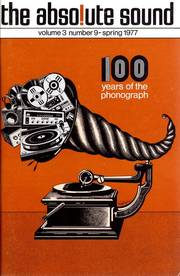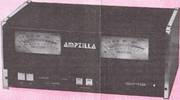Reprint courtesy of "THE ABSOIUTE SOUND" 1977
Reprint courtesy of "THE ABSOIUTE SOUND" Volumem 3 Number 3 - Spring 1977
(hie auch ab und zu als "TAS" referenziert
.
THE ABSOIUTE SOUND is an independent publication about sound and music for discerning audio-philes and musicians. Subscriptions for four issues are available for $12 (sent via third class mail) or $14 (sent via first class mail) or $16 (sent via air outside North America) from THE ABSOIUTE SOUND, P.O. Box 5, Northport, N.Y. 11768.
.
Ampzilla II
Manufacturer: The Great American Sound Company, Inc., 20940 Lassen, St., Chatsworth, Calif. Source: Manufacturer's loan. Serial No. A-102120-B. Price: $909.
.
Die dezente Werbung von James Bongiorno
James Bongiorno, purveyor of oddly named audiobeestes, herewith introduces a newly designed version of his first independent entry into the field. No secrets held back, my friends: This is a wonderful amplifier, likely to become a classic of its time.
Had Ampzilla II been the product of another firm (particularly one blessed with a large advertising and commercial design budget), its appearance might have been attended by loud media hosannas and sexy commercial photographs.
But as it now stands, I have seen no advertisements - not even teeny ones - of its nativity. Even the product itself is hard to distinguish physically from the original Ampzilla:
The only real external distinction, and a subtle one at that, is the addition of a pair of LEDs located just medial to the pair of large (and still very slow-acting) meters mounted upon what appears to be the amplifier's proboscis.
These LEDs are supposed to light up whenever the amp goes into clipping, however instantaneously. At first I doubted this, thinking that they lit up only when Ampzilla II was grossly overdriven. But as I have gotten to know them, I found them immensely more helpful (confirming my own listening experience) than those gracefully undulating but otherwise useless meters.
.
Es ist die zweite Generation des Ampzilla
Other relatively obvious physical distinctions between the two generations of Ampzilla include a new extruded (vs. fabricated) heat-sink assembly, as well as it's greater weight (due apparently to a heftier power supply and associated hardware; the beefed-up power supply presumably explains another of Ampzilla it's properties: The meter lamps, unlike those in the elder model, don't dim appreciably when a loud surge happens by).
But the Ampzilla II comes to us with surprisingly modest pretensions. It costs $100 more than its predecessor and has the same rated power output. Then why do I find Ampzilla II such a supergadget? The name of the game, my friends, is definition.
In the past couple of issues of "The Absolute Sound", the listing entitled "Editor's Choice" has been prefaced by comments which established as prime requisites for editorial beatification a lack of distortion and coloration, particularly in the midrange.
To my ears, Ampzilla II comes about as close to this ideal as any amplifier yet heard. But the way it does it is fascinating: Instead of being merely sterile (as implied by "lack" of distortion and coloration), it is almost surgically romantic.
Imagine a musical signal so clean that you can hear every inner voice uttered with complete lucidity, even to the point of being a bit bare-bones. Imagine this quality being present to an almost razor-sharp degree which verges on dryness.
But now forget about the bare-bones razor-sharp quality, and replace it with an upper-midrange just slightly bright, just slightly tinged with a certain silvery-sweet quality, like a peppermint drop after a big supper.
Or let me restate it: Ampzilla II greatly eschews the kind of hash which so often passes for midrange sound in contemporary amps. At the same time it humanizes the sound by means of a slightly lush high end, a quality which obviously must be counted as a coloration, but a merrily euphonic one.
It's nice to hear, but it probably would be enough to place Ampzilla II just a notch below state-of-the-art ranking.
Vergeliche mit dem "Audio Research Dual 100" amplifier
That not entirely vexing point aside, I really can find very little to complain about with this amp's sound. I truly believe it to be the most detailed I have ever heard with my Dayton-Wright MK1's (though even its 200-watts-per-channel is not powerful enough to drive a pair of MK III's of my acquaintance to a satisfying level). Its low end is unexceptionable. As a matter of fact, this amp proved the most satisfactory of several currently on hand in driving full-range a pair of Infinity QLS-1's, which in their present incarnation virtually demand bi-amping if the bass is to sound like anything more than mud.
Elsewhere in this issue I describe at length my experience with the new "Audio Research Dual 100" amplifier, which arrived at these precincts around the same time as Ampzilla II. This synchronicity of events proved to be most fortuitous, for in two important sonic respects these units are practically the antithesis of one another.
One of these respects, as you might by now have guessed, is Ampzilla II's clear superiority in matters of details and definition. The other respect I have found to be the source of some interesting recent dialogues between myself and other of our staffers. That is the matters of "dynamics range."
Since my colleagues' comments on my D-100 review take lively exception to my praise of that amplifier for its wide dynamic range, it might be worthwhile to mention that Ampzilla II was my most constant point of reference (and contrast) while writing the D-100 review.
In other words, if the D-100 has a very wide dynamic range, then Ampzilla II's is very ordinary. Now let me be a bit more clear on what I mean by dynamic range as it applies to an amplifier. If I play a given recording (preferably classical) through each of these amps successively, leaving the gain setting the same throughout each playing (though not necessarily equal for the two amps), then I at least hear a much wider scale of contrast in dynamic levels, from very soft to very loud, from the D-100 than from Ampzilla II.
Ein toller Verstärker mit nurtzlosen Anzeige-Instrumenten
Note that I am not talking about the two amps' maximum or minimum outputs relative to another, but rather the shadings of volume achieved by each within its available power reserve; its dynamic range, in other words.
In older and simpler times, it might have been possible to dismiss this apparent quality of the D-100 as being due not so much to actual power output as to a kind of fatiguing effect caused by distortion, so that, rather than actually hearing more volume, the listener simply had to work harder to keep from being annoyed by it.
But this is by no means the case here. Though the D-100's opacity in the lower midrange may in itself be annoying, annoyance does not grow as the volume increases.
This quality is no doubt much enhanced by the fact that the D-100 clips in an astonishingly graceful fashion - almost as if there were no clipping at all! So one concludes that the Messrs. Audio Research have invented a sort of new wonder - even though some of my colleagues may not agree on this point.
Now don't let me give you the impression that Ampzilla II is actually somehow deficient in this matter of "dynamic range," for it is at least the equal therein of other amps of similar power rating, being surpassed in my experience only by the D-100 and (to a lesser degree) by the Stax DA-300.
Just how these two lower-power amps do it is beyond my ken. Had not the D-100 come along, I would have continued to suppose that the DA-300's Class A operation was the secret. Now I just don't know.
As for Ampzilla II's own clipping characteristics, this amplifier remains the antithesis of the D-100. While it is capable of putting out plenty of power, it will tell you for sure - both audibly and visually - when it is running out of steam. I mentioned before that I at first mistrusted those newly added LEDs: The tricky part is that when the amp is just beginning to exhibit distress, the diodes flicker only very faintly and very briefly.
By the time they begin to show a good solid red hue, your ears and the amplifier will both be considerably discomfited. But for this to happen at all requires either (a) markedly inefficient speakers or (b) a listener who likes his music a lot louder than I.
Hats off to you, Mr. B. (=Bongiorno) Your new creature may be a bit berouged in the high frequencies, but I suspect that it's going to be my reference standard for a while.
-JWC
Manufacturer's Comment:
Thank you for your fine review on Ampzilla II. Although there is not much to add, I would like to clarify a few points ....
With respect to the discussion of clipping characteristics, it is possible to introduce soft limiting to show the effect you describe. Unfortunately, soft limiting has its penalty, by any means that we have found.
The (apparent) extra dynamic range can be provided for the bass, but takes its toll of midrange and high frequency definition when it is in effect. We have chosen to hold all ranges at maximum definition right to the clipping limit. A comparison of limits is difficult to judge from here since apparently gain levels for playback were not equalized. It is absolutely imperative that the gain settings be precisely matched, as the ear has no memory beyond a few seconds under a direct comparison situation.
Using one D-100 with its soft limiting characteristic, it is possible to push it harder before apparent audible distress occurs, although with a loss of definition.
Using two D-100's in bridged fashion is monetarily unfair ($2,000) and unfair from a power standpoint, as this operational mode gives around 400 watts per channel into 8 ohms versus 200 watts for Ampzilla.
Although we have to work with specific technical matters in engineering terms and with the best available instrumentation, we are trying as hard as we know how to include trained-ears judgment in our decisions.
We value the (golden ears) types. They are valued aids in design, respected
critics, and above all valued customers.
James Bongiorno
"the absolute sound" - Editors Choice
The components listed here are the choices of the editor alone.
These listings are not divinely inspired. They should be read as a guide, not as any manifestation of a final authority. The editor has listed only those components he has heard, and he is solely responsible for the ratings. Cost has nothing to do with any of the ratings, but lack of coloration and distortion in the middle frequencies does (since the middle frequencies are most vital to the accurate reproduction of musical material). That is to say, the first place a component must excel is in the mid-range. Keeping this in mind will explain several seeming anomalies in these listings.
Damals wurde in Klassen gedacht
There is one more important point: The differences between Class I and Class II equipment are exceedingly small. This is especially true for the electronics and speaker systems listed. In most cases, the drop to Class III represents a considerable increase in noticeable colorations. You should remember that all modern-day components suffer from severe failings, especially when you use live musical performances as the ultimate reference, that is, as the absolute sound.
Even the best listeners cannot always detect colorations, if those colorations are common to most equipment and represent the best that technology can do in the endlessly complex procedure of transforming realities through several media. This is another way of saying that until a component that is noticeably less colored and more accurate comes along, we may not detect all the flaws in our equipment.
All of the components listed here are, at the very least, acceptable for those wishing to re-create some accuracy in the illusion of a musical performance, rather than for those who think home music systems should be, - sui generis - , musical instruments rather than music reproducers. Few are mechanically perfect. Not one component listed here is without sonic flaws.
Equipment that fails to perform properly is given a (c) conditional rating: It is subject to being dropped from future listings because of its unreliability. After all, who wants to spend a fortune on something that either won't work unless you're some sort of Great Expert, or something that varies so much from unit to unit that no two samples sound alike?
Several older components officially discontinued by their manufacturers (but still obtainable by the clever), have been listed here and are marked by a dagger (t). Other components have acquired a high ranking, but only when used with specific auxiliary equipment. These are so designated.
"State-of-the-art" is the category reserved for those rare components that are significantly beyond the best overall performance of nearly all other equipment (in terms of low coloration, low distortion and, in this instance, wideband frequency response).
Was die 4 Klassen bedeuten :
Class I indicates components of very low distortion, with little in the way of coloration - but components that have one or more shortcomings when measured against what can be achieved by present technology.
Class II indicates, in our opinion, considerably more coloration in more bands of the audio spectrum, but colorations which are euphonic and which may, when properly matched, add considerable realism to any given system.
Class III includes components that may have very wide frequency response, or, failing that, rather accurate reproduction in certain parts of the frequency range, though with two or more major colorations elsewhere in that range.
Class IV consists of equipment that is, for the money, faithful to the ideals of
musical sound reproduction (and far beyond more expensive and more commercial brand names) with colorations that must be specifically matched to other and complementary components.
Die Liste der getesteten Hifi-Geräte
| STATE-OF-THE-ART | ====================================== |
| Tuners | Sequerra Model One |
| Yamaha CT-7000 | |
| CLASS I | ====================================== |
| Turntables | Technics SP-10 |
| Kenwood KD-500 | |
| Arm | Infinity Black Widow |
| M&K/Rabco SL-8E (t) | |
| Cartridges | Sonus Blue Label |
| Grado Signature (c) | |
| Preamplifiers | Audio Research SP-3a-2 |
| Amplifiers | Audio Research D-150 |
| Double Dyna 400 (Van Alstine) | |
| Semipro Tape Recorder. | ReVox A-700 |
| Tuner | Mcintosh MR-78 |
| Speaker System | Acoustat-X |
| CLASS II | ====================================== |
| Turntables. | Sony 2251 LA |
| Sony TTS-3000/ 3000a (t) | |
| Arms . | J*H Formula Four |
| Mayware | |
| Cartridges. | ADC XLM/XLM Mk ll (c) |
| Preamplifiers. | Infinity FET |
| Levinson JC-2 DB Systems | |
| Amplifiers | Ampzilla II |
| Audio ReseafB* D-76a Stax DA-300 | |
| Tuner. | Onkyo 4055 |
| Semi-pro Tape Recorder. | Tandberg 10XD |
| Speaker System. | Infinity Servo-Statik la (c) (t) |
| Audio Research Magneplanar Ilia (t) | |
| Audio Research Magneplanar l-c (t) | |
| CLASS III | ====================================== |
| Turntable. | Technics SL-110/120 |
| Arm . | Grace 707 |
| Cartridges. | Grado FTE + 1 |
| AKG P8SE | |
| Denon 103c | |
| Decca Mk V (elliptical) | |
| AEC (c) | |
| Pre-amplifier. | Levinson LNP-2 |
| Amplifiers . | Marantz Model 9 (c) (t) |
| Luxman 3045 (c) | |
| Dyna Mk VI | |
| Epicure Model One | |
| Speaker Systems. | Dahlquist DQ-10a |
| ====================================== |



